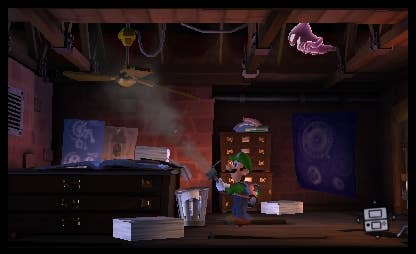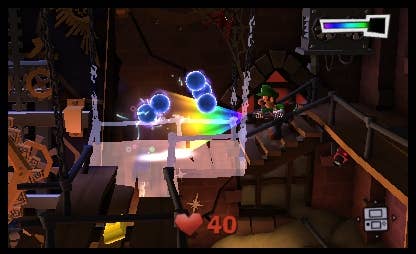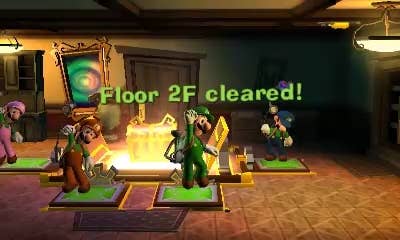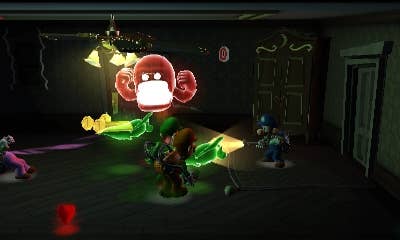2013 in Review: Luigi's Mansion and the Best of Two Worlds
The 3DS-based sequel to Luigi's Mansion shone brightly in both single- and multiplayer -- despite the two modes being markedly different from one another. Pete looks back on one of the year's best 3DS games.
This article first appeared on USgamer, a partner publication of VG247. Some content, such as this article, has been migrated to VG247 for posterity after USgamer's closure - but it has not been edited or further vetted by the VG247 team.
I got a copy of Luigi's Mansion: Dark Moon (or Luigi's Mansion 2, as it's known in Europe) for my birthday this year.
I'd just bought myself a 3DS XL -- primarily to play Fire Emblem: Awakening, which I still haven't finished, as it happens -- and this, naturally, made for some easy birthday presents from friends and family. There were a bunch of games on the platform that I wanted to play, though I must confess that Luigi's Mansion wasn't high on my list. In fact, I'd barely contemplated it at all; I never played the GameCube original, and at that point I still had a rather indifferent attitude towards Nintendo first-party titles in general, and Mario-related games specifically.
Still, with a copy in my possession I certainly wasn't going to just leave it on the shelf -- or, worse, trade it in like some sort of ungrateful asshole -- without at least giving it a go first.
And I'm glad I did.
Dark Moon gradually revealed itself to be something quite different to what I expected.

Dark Moon gradually revealed itself to be something quite different to what I expected. I was expecting a fairly throwaway game about Luigi vacuuming up ghosts, but what I actually got was something far more akin to one of my favorite types of game: old-school point-and-click adventures.
As this realization gradually dawned on me, the raised eyebrows I'd sported during the game's opening gradually gave way to a broad grin as I was continually presented with a series of creative, satisfying and fun puzzles to complete, coupled with "combat" (for want of a better word) that felt brilliantly physical. The feeling of weight as I wrestled with the ghosts in an attempt to suck them into the Polter-Gust made me feel far more in tune with Luigi than many other game characters I've controlled in recent memory -- and called to mind another game I've played with a similar sense of physicality: the excellent and rather underappreciated Wii title Pandora's Tower.
Sucking up ghosts is actually a fairly minor part of Dark Moon's single-player mode, though; the emphasis is very much on puzzle solving, and particularly of determining how you might be able to get somewhere that you can see but not reach.
Dark Moon is a fantastic single-player game, but what a lot of people don't seem to know is that it's also a fantastic multiplayer game.

The Dark Moon designers are very fond of secret passageways and hidden objects, it seems, and initially it can be baffling for there to be no apparent solution to the traversal problem before you. However, the first couple of times you'll almost inevitably come across the solution by accident -- perhaps you'll be trying to suck up a ghost and you'll snag the Polter-Gust on a loose carpet corner, for example, or you'll realize you can vacuum up drapes and hanging tapestries to reveal things hidden behind them. The first time I revealed a hidden passageway in this manner -- and it turned out to be essential to progress rather than a secret area -- it was a revelation. Suddenly I felt the urge to scour all the rooms I'd previously been to once again; now I knew what to look for, and I was usually rewarded for my curiosity in one way or another.
The game as a whole is beautifully paced, though some players disliked the fact it was split into discrete levels within each of the mansions -- they're not Zelda-style dungeons where you work your way through the whole thing in one go. This actually worked pretty well, though, and made the game eminently suitable for handheld play. Rather than having to stop halfway through implementing a solution to a tricky problem, you can generally make a good amount of progress and be rewarded for it, then go back to continue later.
The level-based structure also allows for subtle changes in each of the mansions when you return, too. A new pathway might have opened up; conversely, spiders might have woven their webs over somewhere you could easily get to previously. Even though the basic layout is the same, in many cases you have to reconsider how you make your way from room to room between individual levels. The game always naturally leads you in the right direction, though; even once the mansions are largely open in their final levels, you're never in any doubt as to where you need to go or what you need to do.
In short, Dark Moon is a fantastic single-player game, then. But what a lot of people don't seem to know -- and that a number of reviews didn't seem to mention all that much -- is that it's also a fantastic multiplayer game, and that its multiplayer mode is a very different affair to the rather cerebral single-player mode.
It's genuinely cooperative; at its most simple level, it's just straight-up more efficient to spread out, but if one of you comes across a trap, you'll need a teammate to release you.

Prior to release, when I first heard that Dark Moon would have a multiplayer option, I was skeptical. Surely it couldn't work, I thought. Surely it'll be tacked-on multiplayer for the sake of multiplayer.
I was, of course, wrong; this is Nintendo we're talking about, and it's very rare for Nintendo to tack something on to a game without a very good reason. As such, I was both surprised and delighted to find that Dark Moon's multiplayer was an immensely solid game in its own right.
Dark Moon's multiplayer component has several modes, all of which are worth your time. They're all variations on a theme, though: you and up to three friends have to work your way up the various randomly generated floors of a ghost-infested tower, then defeat a boss on the roof. As you successfully complete challenges, you'll unlock the option to challenge taller and taller towers, until you eventually unlock the capability to play an "Endless" mode where you just have to see how far you can get.
The interesting thing about Dark Moon's multiplayer is that it's genuinely cooperative -- all members of your team need to work together. At its most simple level, it's just straight-up more efficient to spread out and try to clear out different parts of the floor independently from one another, particularly since the time limits are quite tight, but if one of you comes across a trap, you'll need a teammate to release you.
Luigi's Mansion: Dark Moon effectively provides two games in one, both of which are strong enough to stand in their own right.

Nintendo's not all that fond of voice chat in a lot of its games and Dark Moon is no exception, but it's less of a problem to cooperation in online play than you might think; instead, you're provided with four stock phrases mapped to the D-pad, and can draw the other players' attention to a point on the map by using one of them. If you're stuck in a trap, for example, push down on the D-pad and Luigi will both call for help and mark where he's stuck on the map for your teammates to come and assist. If you're playing via local wireless connection, of course, you can simply tell your comrades what the problem is -- it's still worth using the D-pad callouts to mark where you are, though.
Cooperation is also essential for the "Red Coin Scramble" that takes place at the end of each level; four red coins appear in the most inconvenient places possible, so you'll have to carefully plan your route to grab them all against a very strict time limit. It initially looks very difficult, but the basic strategy is relatively simple and doesn't require much direct communication -- simply spread out to ensure you're covering as much ground as possible between you.
The most interesting thing about Dark Moon's multiplayer mode, though, is that it provides potentially limitless replay value. While the single-player is a very structured, linear affair with relatively little to go back and re-investigate once you've seen everything, the levels in multiplayer are randomly generated every time you play them, making for a markedly different experience in every session. The randomly generated nature does mean that the puzzle aspect of single-player takes a back-seat to the ghost hunting, but the three different modes of play between them provide more than enough interest to make up for the lack of any real brainteasers.
To sum up, then, Luigi's Mansion: Dark Moon effectively provides two games in one, both of which are strong enough to stand in their own right as a worthy successor to the GameCube original. To have them both in a single package represents excellent value, and I'd really recommend you give them both a shot -- even if you're not normally a big fan of multiplayer options. You might just be very pleasantly surprised.




_ddwYK80.png?width=291&height=164&fit=crop&quality=80&format=jpg&auto=webp)



